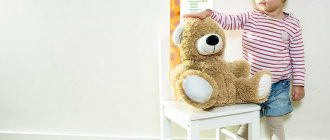December 21, 2016
Averyanova Sveta
A fitball is a round gymnastic apparatus, a large elastic ball. Adults and children use it. Fitball classes for newborns at home are easy to organize, even for inexperienced parents. When to start, how to conduct training and what are the benefits of gymnastics on a ball for young children, we’ll talk in our article.
What are the benefits of fitball?
A fitball is both an exercise device and a toy. Pediatricians recommend using it from the very first months of life not only for motion sickness, but also for gymnastics.
For newborns and children up to one year old, fitball is useful in the following ways:
- allows you to develop an excellent vestibular apparatus;
- improves coordination of movements and orientation in space;
- helps in the treatment of hypertension;
- reduces the symptoms of colic, by relaxing the abdominal muscles, digestion improves;
- improves back muscles, helps to form correct posture;
- calms, since the movements on the ball are similar in intensity and amplitude to the movement of the baby in the mother’s belly.
Fitball for infants: indications and contraindications
Pediatricians recommend exercises on a fitball for harmonious physical development for most infants.
There are some medical indications for using the ball:
- hypertonicity of any muscles;
- retardation in physical development;
- dysplasia;
- muscular dystrophy;
- digestive disorders;
- severe colic;
- frequent whims, sleep disturbances.
Fitball is not always beneficial for babies.
Classes are contraindicated in the following cases:
- the child does not like it, during exercises he begins to be capricious and twist;
- the child has a fever, cough, runny nose;
- the umbilical wound does not heal well.
How to choose the right ball
The usefulness of exercise on a fitball for infants depends on the quality of the ball.
When purchasing, you must adhere to the following parameters:
- Volume. For the whole family, it is recommended to purchase a fitball with a diameter of 75 cm. If only the baby needs a gymnastic ball, a product from 45 cm will be suitable.
- Material. It is recommended to use balls made of material that does not electrify and does not have an unpleasant odor.
- Elasticity. The benefits of exercises on a fitball depend on it. In the store, you can check the material by lightly pinching the ball. The fold should straighten out very quickly. Elasticity can be checked in another way: by pressing firmly with your palm on the surface of the ball. The more it springs back, the better the quality of the product.
- Color. According to statistics, fitballs in pastel, gray and soft colors are of better quality and more pleasing to the eye. Too poisonous shades are more common among fakes.
- Explosion protection. The fitball should have a sticker or mark indicating the presence of anti-explosion protection, most often this is the abbreviation ABS. Such balls can withstand a load of 300 kg; if damaged, they do not explode, but deflate.
- Surface. A smooth, warm surface without adhesive seams is a sign of the quality of the product. The ball nipple must be soldered inside.
- Availability of additional elements. Fitballs can be completely round or have “horns”. For newborn children, the latter are useless, as they can interfere with exercise. Balls with horns are recommended for children who are confidently sitting or learning to walk. With their help, the child will be able to control his balance.
How and how much you need to exercise on a fitball
Physical exercise on a fitball for infants is recommended daily. For medical indications, exercises are performed several times a day. For newborn babies, a few minutes are enough; at six months this time gradually increases to 10 minutes. In the future, you can focus on the child: if he likes it, the duration of the gymnastics can be increased to half an hour.
Class time is selected individually, based on the baby’s daily routine. It is important that the child is not sleepy, and that at least 1 hour has passed since the last meal. Infants are especially active in the morning, so pediatricians recommend using the time between morning feeding and naps.
Daily exercises on a fitball for infants are accompanied by soft, light music; you can use various nursery rhymes and children's songs.
Video: Fitball for newborns - video of exercises on a fitball
Before starting the exercises, parents should take into account the recommendations of experts on training on this apparatus:
- When to start? Hiding the ball until the baby gets on its feet is completely optional: you can start fun and useful training immediately after your beloved child, brought from the maternity hospital, enters the natural mode of sleeping and feeding. That is, he will get used to his home environment. The second condition is a healed umbilical wound. On average, classes begin at 2-3 weeks of age.
- The ideal time for exercise is an hour after the baby has been fed. Not earlier. It is strictly not recommended to start exercising immediately after eating - in this case, the fitball will do more harm than good.
- During the first lesson you should not get carried away. The first lesson is short. Mom should feel the ball and gain confidence in her movements. Usually, parents who place their baby on the ball for the first time do not even understand which side to hold the newborn on and how exactly to do the exercises. Therefore, first you should sit on a chair in front of the ball, cover it with a clean diaper, carefully place your child on the center of the ball with his tummy and rock him a little. The amplitude of movements (swinging/rotating, etc.) increases gradually. With an undressed baby, classes are much more comfortable (the child’s stability is higher), but for the first time you don’t have to undress.
- During the exercise, you should not pull or hold the baby’s feet and hands - children’s joints (wrist and ankle) are not yet ready for such a load.
- An activity with a baby will be more interesting and more beneficial if you play calm classical music during the exercises. For older kids, you can play more rhythmic music (for example, from cartoons).
- If the baby is not feeling well or is not in the mood for fun and activities, it is strictly not recommended to force him.
- For the first lessons, 5-7 minutes are enough for all exercises. If you feel that the child is tired, do not wait until these few minutes have passed - stop classes.
- The optimal fitball size for a newborn child is 65-75 cm. Such a ball will be comfortable for both the baby and the mother, who will benefit from the fitball in returning to her previous shape after childbirth.
Classes for children 1-2 months old
The main goal of gymnastics on a fitball at 1-2 months is to improve digestion and prevent colic.
A set of fitball exercises for infants in pictures
At this time, the following exercises are performed:
- The child is placed with his stomach on the ball. An adult needs to support the shoulders and head with one hand, and the legs and hips with the other. Perform 5-6 swings forward and back.
- The baby is turned over and held in a similar way, but he is already lying on his back. 5-6 swings are performed. At 2 months you can add movements in a circle, left and right.
- The child is placed on a bed or sofa so that his legs hang down from the knee. Gently holding it, mom rolls up the fitball. Instinctively, the child pushes the ball away. The exercise is repeated 5-6 times.
Exercises for babies
The first exercises on the ball can be started gradually from the age of two weeks, and for this you need to select a special time - no earlier than an hour after the last feeding. Acquaintance with the fitball should be short - its surface is covered with a diaper, the baby is carefully placed on top on his tummy, and slightly holding the little athlete with his palm behind his back, the parent should easily move the ball back and forth and to the sides with a small amplitude.
Gradually, you can introduce other exercises, adding variety and lengthening the program:
- to the already familiar sideways movements, you can add circular rocking in a similar position;
- you can also perform similar actions, only placing the baby not on the tummy, but on the back;
- in a face down or up position, press slightly with your palm on the back or tummy of the baby, causing the ball to spring a little;
- the baby should be placed on his back on the bed and a ball should be rolled to his legs so that he pushes it away from himself;
- The following exercises are for older babies (from 6 months). While lying on the tummy, parents hold the child by the legs and gradually tilt the ball forward so that the child’s arms reach the floor. To make everything interesting, you can lay out a few toys in front of the fitball, and then the baby will be happy to reach for them;
- this is probably the most fun exercise, which is always accompanied by loud laughter - we fix the ball between our knees, holding the baby, as if we put him on the ball and show how to jump, pushing off with his legs;
- the baby is lying on the ball on his stomach, one parent holds his hands in the forearm area, and the second holds his shins. The essence of the exercise is to roll the baby back and forth on the ball;
- from 8 months you can try to stand on the ball, while the fitball should be well fixed in one position, and parents should protect their baby from falling at all times.
Gallery “Positions of the baby on the fitball”
Exercises for babies from 2 months
At this age, children know how to hold their head up, so the exercises can be made more complicated, and gymnastics can be added to strengthen the muscle frame.
- The child is placed on his stomach. You need to hold his buttocks with one hand, and clasp his ankles with the fingers of the other. You need to make sure that the baby wraps his hands around the ball. During exercises, the child is rocked back and forth. Number of executions – 10.
- The baby is placed on his back on a fitball. One hand fixes the chest and shoulders, the other the hips and legs. It is necessary to perform swinging movements, lightly pressing on the ball. 10-12 swings are performed. With each subsequent one, you need to speed up the pace.
- The child is placed on his side. He holds the arm and shoulders with one hand, and the legs with the other. Light springy movements are performed, 10 repetitions. The exercise is repeated on the other side, on the stomach and back.
- The child is placed on his stomach, holding his back. The baby's legs and arms should clasp the fitball. Slowly the ball is rotated back and forth to its maximum length. It is recommended to complete the gymnastics with this exercise.
Exercises
Training complexes for fitball are usually divided into several groups according to the age of the infants. Parents should understand that these tasks are classified as general strengthening tasks and are intended for children without developmental pathologies.
To solve health problems with the help of a fitball, we recommend that you consult a doctor. The doctor will prescribe a special course of gymnastics, which will be more effective and targeted.
Exercises for children up to 3 months
Newborn babies love to swing on a fitball. The basic gymnastic exercises for babies of this age are based on this principle. The baby is laid on his tummy, the mother sits on the floor or stands nearby so that the hold is strong. Complete the following tasks, devoting 1-2 minutes to each.
Swing
The exercise is performed on the stomach and back alternately. In the stomach position, hold the baby with your hand, placing it in the area of the shoulder blades, and clasp the legs with the other palm. Make swaying movements left and right, back and forth. In a supine position, it is better to clasp the ball with your legs so that the fixation is stronger.
Spring
A two-month-old baby lies on a fitball with his belly. Hold the baby's legs and lightly press on the butt so that the ball bounces up and down.
Leg kicks
Mom’s pet or darling lies on the sofa, a fitball is rolled up to his heels. The baby rests his feet on the ball, the surface is springy.
Watch the video on how to perform these exercises:
Classes for children from 3 to 6 months
Gymnastics with a fitball is much easier to do at the age of three months. The baby holds his head, his neck is stronger, he rests his hands on the surface, tries to roll over and sit down. Help him learn new tasks and his physical skills will develop faster.
Wheelbarrow
The baby lies face down, resting his hands on the projectile. Mom swings the fitball forward, taking a couple of steps, then back. The child is forced to move his palms to maintain position.
Reach for the toy
The baby is placed on the belly and held well by the legs. Tilt the fitball forward so that the baby can reach the floor with his palms. Place several bright toys near the ball, the baby will try to get them.
Jumper
The most favorite exercise for infants. Place the baby on the ball and hold it under your arms. Hold the fitball with your feet. Help your child jump, make sure he bends his knees and pushes off on his own.
Airplane
Lay the baby on his stomach and rock him on the ball a couple of times
Gently secure the baby's forearm and lower leg and turn him onto his side. Rock on one side, then reverse position
Watch the exercise video below:
Exercises for children 6 months and older
In six months, it is important to strengthen the muscles of the legs, back, and spine. Fitball exercises are aimed at teaching sitting, standing, walking, and training the vestibular system.
Downloading the press
The baby is placed on the back. The ball is firmly fixed with the feet of an adult
The mother pulls the baby by the arms, holding the forearms, sits the baby down, then carefully lowers him to his original position.
Learning to stand
The fitball acts as a support for the baby. The mother places the child near the ball and rests the child’s palms on it. Hold the projectile so that it does not roll away. Slowly release the child and let him stand on his own. 2-3 seconds is enough.
Drag
Requires two adults to complete. One holds the child by the legs, the other by the hands. The baby lies face down
Parents carefully pull the baby towards them one at a time
horse
The baby must be able to sit. The mother puts the child on the exercise machine astride and helps him bounce on his butt. You can press the ball so that it springs along with a small load.
Keeping your balance
Place the baby on the fitball and find a fulcrum.
Place your hands on your child's lap. Let him sit for 3-5 seconds almost independently, keeping his body in one position.
Exercises from 4 months
At 4 months, the child holds his head well, controls his hands and begins to navigate in space. Fitball becomes a big toy for him. The baby tries to push it, pinch it, taste it. The following exercises are recommended during this time:
- The baby lies on his back on the floor. An adult should roll the ball to his feet and ask him to push it away. 15-20 repetitions are performed.
- The baby lies on his stomach on a fitball. An adult, holding him by the armpits, moves the child back and forth. At the end of the amplitude of movement, you need to linger for 5-6 seconds. This helps to arch and stretch the muscles around the spine. 5 movements are performed.
- The Fiball is located close to the wall or sofa. The child lies with his stomach on the ball, his feet touching the wall. While holding the baby, you need to roll him to a hard surface so that his legs bend at the knees, and then let him push off with his heels. During the exercise, the muscles of the calves, thighs and back are trained, and the body is prepared for walking. Number of approaches: 5-6 times.
- The child lies on his stomach on a fitball. You need to put a bright toy near the ball. Holding the baby by the legs, the adult tilts the fitball towards the toy until the child grabs it. It must be remembered that you cannot stay in this position for a long time. Repeated 3-4 times.
- The exercise is performed similarly to the previous one, but the toy is placed slightly to the side of the fitball. To get it, the child needs to turn his head to the side and reach with his hands. This perfectly trains the vestibular apparatus and spatial orientation.
Basic exercises for children
Today there are many sets of exercises for fitball, but do not rush to master everything at once.
Choose the ones you like and start practicing with your child gradually. The main thing is that the activities bring joy and pleasure to both of you. Important! In order for the child to get used to and not be afraid of exercises on a fitball, during them you need to talk to him calmly and affectionately. You can also play calm music.
Under 3 months
For such a tiny baby, all exercises should be very soft and easy, without sudden movements. A child of this age still does not hold his head well, so you need to constantly make sure that it does not tip back. Until the navel heals, exercises for newborns can only be done on the back. Since the baby’s bones are still quite fragile, you should not hold the baby by the feet or hands, so as not to accidentally injure them.
- “Cradle” - the baby lies on his back, and the mother, gently belaying him, easily rocks him back and forth or left and right.
- “Spring” - the mother fixes the legs of the child lying on his stomach, gently and abruptly presses on his butt, while the fitball springs up and down.
- “Football” - the baby lies on his back on the floor or bed, the adult slightly presses the ball on the child’s feet, and he instinctively pushes the ball away from himself.
- “Around the world” - place the child on his back on the ball and, gently fixing the baby, slowly rotate the fitball clockwise and back.
- “Bouncer” - place a child who can hold his head well on the ball, which will cause active movement of his legs.
3-6 months
The baby has already grown a little, holds his head well, leans on his forearms and grabs the handle of the fitball. You can already see from the baby how he likes to study and what he loves most. Therefore, the set of exercises becomes a little more complex and varied. At 3-6 months, you can no longer hold the child by the back or tummy, but only secure the legs and forearms.
Learn about infant swimming.
- “Wheelbarrow” - place the child on his stomach and, holding him firmly by the ankles, push the fitball forward and back.
- “Fishing” - an adult holds a baby lying on his stomach by the legs and tilts the ball so that the child can take the toy from the floor.
- “Pumping up the abs” - holding the baby lying on his back by the forearms, slowly lift him into a sitting position and just as slowly return him back.
- “Airplane” - place the baby on the tummy and slowly turn it onto its side, securing it by the forearm and lower leg and lightly massaging the free side with a back and forth motion.
Over 6 months
The baby has grown a little more, has become more active and inquisitive and is getting ready to take his first steps. At this stage, the fitball will help him strengthen his muscles and prepare for active walking.
Did you know? A study of the behavior of newborns showed an interesting fact - boys pay more attention to human movements, and girls watch the face.
- “Rolling” - put the child near the ball and pull him by the handles on the opposite side so that he ends up on the fitball, then return the baby to the starting position.
- “Pull the rope” - put the child on the ball on his stomach and, with the help of another adult, insuring the child by the forearms and shins, roll him so that the back periodically hangs in the air.
- “Spring” - put the baby on the ball and show how he can spring and bounce on it.
- “Balance” - put the child on a fitball and, carefully holding it, achieve balance, then release your hands, which will force the baby to try to balance.
For mother and child
Fitball is also useful for a young mother; with its help, she can recover faster after childbirth and return to her previous shape. In addition, joint exercises between mother and baby will bring maximum benefits and joyful emotions for both.
For a joint activity, sit on the ball with your baby in your arms and lightly bounce up and down. In this way, the hips and buttocks are pumped up, and the spine is relaxed. For babies, this exercise is similar to gentle rocking, which usually makes them fall asleep. And for mom, this method of motion sickness is much easier, since it does not put as much strain on the muscles of the back and arms.
Also, during breastfeeding, you can place your feet on a fitball, which will relieve tension from them and improve blood circulation. And in her free moment, mom can do the “Cradle” exercise, gently rocking on her back or stomach.
Exercises for children from 6 months to one year
At this age, many children try to sit and then walk. Their muscles and bones require more intense training to become well strengthened. At this time, fitball helps accelerate physical development and improve coordination in space.
- An adult sits on the floor and holds the fitball between his legs. The child must be seated or placed on the ball. Springy squats or jumps are performed. Children really like this exercise, so you can do it for 5 minutes with breaks of 10-15 seconds. Daily gymnastics with jumping on a ball perfectly trains the vestibular system.
- The exercise is performed with children who sit well and hold their back. The child is placed on a fitball. The adult holds the child by the waist with one hand, and the outstretched arms with the other. The baby's task is to maintain balance. The exercise is performed for 25-30 seconds. After a while, you can complicate it: hold the child only by the hands.
- The child is on the fitball with his stomach, his hands are clasping the ball. An adult raises the baby's legs at the level of his body and swings the ball back and forth, imitating working with a wheelbarrow. 10-15 movements are enough.
- The child lies on his back, his legs can be lightly supported by his hands. An adult pulls the child's arms from a lying position to a sitting position. It is recommended to say “get up” and “sit down.” The exercise is useful for children who do not yet sit independently. 5-6 approaches are performed.
- The child stands on his legs, the adult holds his waist with his hands. The fitball serves as a support, which rolls to the side when pressed. This encourages the baby to take steps. The exercise is performed for 4-5 minutes. It is only suitable for those children who can stand on a support. It is necessary to insure the baby by holding him by the waist even if the child is already walking independently.
Fitball exercises as a way to prevent colic in babies
Colic is the main problem for babies and parents in the first three months of life. Since colic causes severe pain in the child, parents are looking for all sorts of ways to get rid of it as soon as possible and prevent it from recurring. In this article we will talk about exercises on a fitball, which will bring not only benefits, but also a lot of pleasure, and will also serve as a prevention of unpleasant colic in infants.
The benefits of exercising on a fitball
As a rule, babies really enjoy playing on a large ball, and they perceive this process as a game. Swinging on a fitball is a passive “swimming” that the child is accustomed to while in the womb. It is for this reason that exercises on a large ball bring pleasure and positive emotions to the child. This is only beneficial for parents, because the baby will not be capricious and will begin to accept physical activity normally. You can exercise on a ball from the age of two weeks, if there are no contraindications (consult your pediatrician regarding this issue). If the doctor recommends placing the baby on his stomach, then exercising on a fitball will not do any harm.
Most parents use fitball to improve digestion and prevent colic in infants. This effect is achieved because rocking in combination with pressure on the tummy allows you to relax the abdominal muscles as much as possible. But this is far from the only benefit of such activities.
In addition to preventing colic, ball exercises will help reduce muscle hypertonicity, which occurs in almost all babies. Rocking on a fitball develops the child's vestibular apparatus and coordination of movements. The entire musculoskeletal system will develop rapidly if you perform exercises on the ball correctly. Even the simplest of them will strengthen the abdominal and back muscles, which is the prevention of poor posture. It should also be noted that stress on the respiratory and cardiovascular systems during exercise also helps improve their functioning. Physical activity can strengthen the body as a whole, increase its endurance and improve immunity.
How to choose a fitball for exercising with a baby?
To begin with, it is worth noting that a fitball is a large colored ball that was created back in the 50s of the 19th century. Physiologist from Sweden S. Kleinvogelbach developed and used such a ball for special gymnastics for patients with central nervous system disorders, as well as for spinal injuries. But just a couple of years later, fitball began to be successfully used in other industries, considering it one of the best exercise machines. In order for exercises on the ball to be effective and beneficial, it is necessary to choose it correctly.
Diameter. To practice with a newborn, you will need a ball with a diameter of 75 cm (if it is larger, it will be uncomfortable for the child and parent to exercise on it). 75 cm is the optimal ball size, which, by the way, can be used by other family members for gymnastics. This will especially appeal to young mothers who are in a hurry to regain their former figure. For children, this size of the ball will be useful for activities from two weeks to 5 years. You can also play with him, but under adult supervision.
Elasticity and plasticity. An important criterion for choosing a ball is its elasticity. If you apply light pressure to the ball, you will feel a slight bounce and bounce rather than a strong response pressure. Exercises on a “hard” ball will not bring the desired effect and will not be as comfortable and enjoyable for the baby. It is also worth paying attention to the plasticity of the ball. It should not lose shape when repeatedly deflated or inflated or reused. If it seems that the ball is made of a very thin material, you can try to “pinch” it slightly - the presence of small folds after this procedure will mean that the product is of low quality.
Strength. It is recommended to use a fitball that can withstand at least 200 kg. This will allow not only the child to practice, but also an adult to lean on, sit down and even exercise on this ball. There are also balls with the ABS system (anti-aging system), which are especially welcome when working with children.
On a high-quality fitball, the seams that are formed when parts of the product are welded together are almost invisible. It is also worth paying attention to the nipple, which should not interfere with work, since it is ideally soldered inside, which will confirm the high quality of the product. The material for the production of the fitball must be hypoallergenic - pay special attention to this, because you will be exercising on it with your child.
How to do gymnastics on a fitball correctly. Basic exercises
As already noted, exercise on a fitball can be started from two to three weeks of age in the absence of contraindications. It is better to practice when the baby is in a good mood. Do not exercise immediately after eating - the child may vomit. It's better to wait 30-40 minutes and only then start. Please note that the room where the classes will take place should not be hot, and it is better to dress the child in comfortable clothes. When exercising, it is always necessary to rely on how the child reacts and behaves.
The first lessons should not be long and complicated; it is better to start with simple exercises: rocking on the stomach and on the back:
Rocking on your stomach. We place the child on the fitball with his stomach down, while holding him by his back. Let the baby lie down for a while and get used to the new position - 1-2 minutes. Then start lightly rocking up and down, left and right. Over time, add rotation in a circle.
Rocking on your back. After doing the exercise on your stomach, you can move on to rocking on your back. This exercise does not have to be introduced from the first lesson; it can be introduced from the second or third. Rocking on your back is best done after exercising on your stomach. We put the child on his back and, holding him by the tummy and chest, perform light rocking up and down, left and right, in a circle.
These two exercises will help the child and parent get used to the ball itself and to the new sensations. Then you can move on to more complex and longer classes.
Today there are a huge variety of fitball exercises. Let's consider the basic complex. In any case, the first exercises of the complex will always be rocking on the stomach and on the back - this is how we prepare the child’s body for more complex exercises.
Spring. We place the baby on his tummy and hold him by the ankles with one hand. With the second hand we make light pushes (press) in the area of the back and buttocks. The same can be done while lying on your back.
We push the ball. Place your baby on a sofa or bed with the legs hanging slightly down.
After 6 months, you can add a more complex exercise: move a ball to your feet and let the baby push it with his feet (this usually happens instinctively). This exercise will help your feet become stronger and allow you to start walking faster.
The swings are difficult. The basis remains the basic exercise with the addition of new components. We expand the amplitude of swaying. We learn to hold the child first by the knee joints, and then by the ankle joints. Rock while lifting the baby's legs. Over time, add the element of hanging upside down (for a short time).
Jumping on the ball. Children love this exercise very much. We sit on the sofa and fix the ball between our legs. We sit the baby on top of the ball and spring - make up and down movements.
The same can be done while standing on the ball.
Grab it. We place the child’s bright and favorite toys on the floor near the ball. Place the baby on the ball with his stomach down. While rocking, let the child grab the toy from the floor - let him reach with his hands.
Wheelbarrow. Position lying on the ball with your stomach down. Raise your legs up and let the child balance on the fitball for a while (several minutes). And we lower our legs.
Airplane. The child lies on the ball with his stomach down. Holding the baby by the shoulders and right shin, we rock. Then we do a similar exercise, holding the left shoulder and shin.
Rider. Lying position on your back. We transfer the child to a sitting position and, holding him by the shoulders, give him the opportunity to balance on the ball for some time.
Then we put him back on his back.
Toad. The baby is lying on his back. We hold him by the shin and roll the ball towards us - the child bends his legs. Then we roll the ball back - the legs unbend.
This is a basic set of exercises that can be expanded, complicated and supplemented as the child grows older.
Exercises on a fitball will help you go through such a difficult path of developing the gastrointestinal tract faster and easier by reducing the manifestation of colic. To prevent colic, in addition to exercising on the ball, you can also do a special massage for newborns. Sports and movement are health, so teach your child to physical activity almost from birth. This will help you learn to crawl and walk faster, and will also be an excellent preventive measure for almost all diseases.
Unfortunately, ball exercises and special massages for newborns are only part of the comprehensive prevention of colic. In order to completely rid a child of colic, it is worth using a special modern drug, Kolikid. Simethicone, the main active ingredient, reduces the surface tension of gas bubbles in the intestines and eliminates them. The released gases can be absorbed by the intestinal walls or released naturally, relieving the painful sensations of the baby. Remember that colic cannot be waited out; it must be eliminated as soon as possible so that the child does not feel pain.
Taking Kolikid during or after meals, as well as before bed (if necessary), the child will be less susceptible to colic. And in combination with exercises and massages, you can completely forget about them.
A set of exercises for dysplasia
Dysplasia is a joint deformity that, if left untreated, can cause inflammation and lameness in the future. The pathology can be successfully treated with special clothing, massage and gymnastics. For a positive effect, exercises must be done daily.
- The child is on his back. An adult fixes him by the stomach with one hand so that the pelvis is fixed, and with the other he alternately makes circular movements with the lower limbs. Number of approaches: 4-5.
- The child continues to lie on his back . An adult secures the baby with one hand, and with the other performs an exercise that imitates riding a bicycle. Can be performed on each leg separately 4-5 times.
- The baby is placed on his stomach and his hands clasp the fitball. An adult alternately bends his legs at the knee and hip joints, imitating the pose of a frog. The pose is fixed for 5-6 seconds, then the ball rolls back and the legs straighten. 8 approaches are performed.
- Position on the stomach. The technique is similar to the previous one. During its execution, the knees are separated as much as possible and the heels touch. The fitball moves back and forth, the folded heels are moved towards the buttocks for a few seconds, then the legs are straightened. 4-5 approaches are performed.
A set of exercises for muscular dystonia
Muscular dystonia is a disease in which tone is reduced or increased. For treatment, massage, exercises in the pool and on a fitball are used.
- The child is placed on his stomach on a fitball. Legs should be bent at the knees and pressed against the ball. One of the parents holds the child by the hands, the other holds the legs. During the exercise, the child is rolled forward and backward. The number of movements is no more than 10.
- The child is on the ball with his stomach. The legs are supported by the hands of an adult. The fitball slowly leans forward until the child touches the floor with his hands. Then the exercise is performed in a similar way, but the hands are holding. Can be performed at 6 months of age and older. Number of approaches: 3-4 times.
- The child is placed with his back on the fitball. Supporting your stomach, you need to perform 5-6 springy movements with smooth rolls back and forth, left and right. The lesson is conducted for children 2-6 months old.
Advice from Dr. Komarovsky: what not to do during classes
The famous children's doctor Komarovsky believes that fitball exercises are only useful if they are performed correctly.
The following tips must be followed:
- It is strictly forbidden to engage in any gymnastic exercises if the child does not feel well, has a runny nose or fever;
- It is better to postpone exercise on a fitball for babies if the baby is capricious or wants to sleep;
- You can’t put a child on a “naked” fitball: firstly, the rubber is cold and unpleasant to the body, and secondly, it can stick and injure the skin;
- you cannot use a fitball immediately after birth: the musculoskeletal frame of the baby will be ready for the first rocking exercises only 2-3 weeks after discharge from the hospital;
- accuracy is an important element of the exercises: the exercises should not be carried out very intensively, especially in the first months, strong pressing and swinging can lead to muscle injuries;
- You should not leave your baby’s head and neck unattended for up to 5 months; even if he holds his head well, lack of support can cause a dislocation of the neck.
Fitball exercises for mothers and babies can be combined. There are a number of exercises that not only improve the baby’s health, but also help the mother get in shape faster after childbirth.
Gymnastic ball, for children: Selection rules
When choosing a children's fitball, you should give preference to famous and well-established brands. The thing is that cheap fitballs from unknown manufacturers will be able to support the weight of your baby, but whether the ball will support you or another adult remains a question. Moreover, low-quality manufacturers can produce fitballs from rubber, which is painted with toxic dyes that can cause harm, cause allergies, irritation and even poisoning to the baby. Considering these facts, purchasing a high-quality fitball is the main criterion for making the right choice. Fitball is a joy that brings benefits!
You can buy a fitball in our online store “Tanita-shop” at an attractive price!










